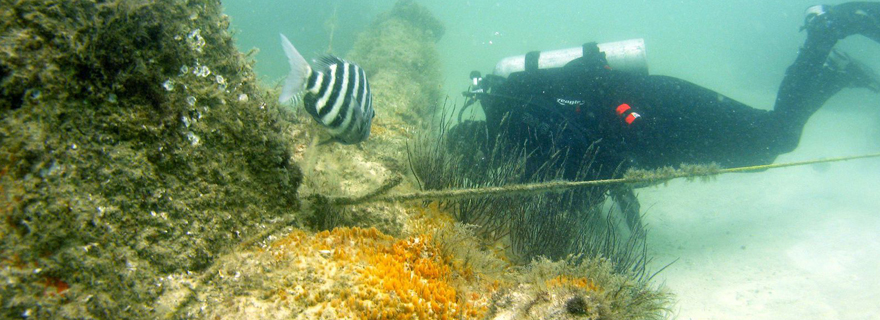[printfriendly]
[su_pullquote align=”right”]Top photo courtesy of the Florida Aquarium
[/su_pullquote]
By Marcia Biggs
After nine years of work, the USS Narcissus, a Civil War era tugboat-turned-warship that sank off the north end of Egmont Key, has become the state’s 12th underwater archaeological preserve.
In a dedication ceremony held earlier this year at the Florida Aquarium, local historians, researchers and divers joined dignitaries from the state, U.S. Navy, U.S. Coast Guard and Congressional staff members to watch a live video and audio feed from the underwater site where a bronze plaque was placed to commemorate the loss of 26 U.S. Navy sailors.
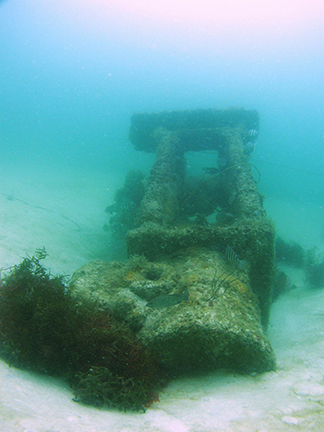
The final resting place of the Narcissus is 2.75 miles west of Egmont Key near the mouth of Tampa Bay. Various pieces of wreckage lie scattered on a sandy bottom in 15 feet of water. Depending on sand coverage, it’s possible to see the four-bladed iron propeller and various components of the boiler and stern assembly. The nearly intact engine is one of the most interesting aspects of the site.
The long road to designation as a state underwater archaeological preserve began in 2006 when the Florida Aquarium began the research needed to produce a comprehensive Tampa Bay Historical Shipwreck Survey.
“Since the 1980s there were reports by recreational divers and fishermen that there was something down there but nobody knew what it was,” says Mike Terrell, who spearheaded the survey project as director of husbandry at the Florida Aquarium. “In the late 1990s an archaeological survey was sent to try to identify the wreckage.
We suspected it was the Narcissus but at that time it was under six feet of sand with only a few small pieces exposed.”
In 2006, the aquarium hired Nicole and John “Billy Ray” Morris of South Eastern Archaeological Services (SEAS) in Kure Beach, North Carolina, to direct the shipwreck survey project. A crew returned to the site to discover the sand had shifted to uncover larger pieces of the ship. The Morrises delved into researching the vessel, with Nicole so intent on identifying it that she based her master’s thesis on the project.
Over the next three years, with the assistance of the aquarium’s volunteer divers, the Morrises were able to survey and finally identify the wreck as the Narcissus. Built in 1863 in Albany, NY, the 81-foot wood-hull tug served in the Civil War at the Battle of Mobile Bay.
On January 4, 1866, Narcissus was heading to New York to be decommissioned when she grounded on a sandbar during a fierce storm, exploded and broke apart. The entire crew of 26 U.S. Navy sailors perished.
In 2010, the Aquarium approached the state about designating the site as an underwater archaeological preserve. All 12 preserves are protected state historical sites, but the Narcissus is unique.
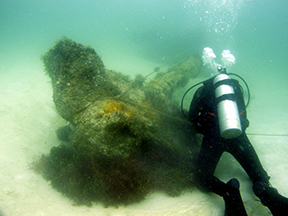
“The Narcissus is considered a military grave and remains the property of the U.S. Navy,” says Franklin Price, a senior archaeologist with the Florida Division of Historical Resources who worked on the ship’s designation. “In this project, we partnered not only with the Florida Aquarium, but also with the U.S. Navy.”
Florida’s Underwater Preserves
In 1987, the Florida State Department Division of Historical Resources began to develop a statewide system of underwater parks featuring shipwrecks and other historic sites.
“The program serves to educate the public about shipwreck sites and allows them to interact,” says Roger Smith, supervisor of underwater archeological preserves at the Florida Division of Historical Resources. “The sites are destined to become tourist destinations for recreational, cultural and ecological use.”
All sites must meet certain criteria, he says. “They must be accessible to the public, meaning they can’t be too far offshore. They need to exist in state-managed water and be positively identified.”
Florida’s 12 underwater archaeological preserves span the coast from Pensacola to Fort Pierce. The wrecks range from a Spanish treasure ship, to a German sailing yacht, assorted steamships and even a vessel that sailed to Antarctica with Rear Admiral Richard Byrd. An estimated 30,000 divers visited the sites in 2013, according to a state report.
The shipwreck preserves are popular attractions for snorkelers and divers not only for their historical significance, but also for an abundance of marine life that make the sites living museums in the sea, says Smith.
“Sunken wrecks are havens for marine life,” he explains. “They provide safe habitat for fish and over time an entire ecosystem will form. Each site has its own unique marine life profile. Wrecks in rivers can attract freshwater fish, manatees and alligators, while ocean wrecks can become artificial reefs and harbor generations of fish, spiny lobster, sponges and coral.”
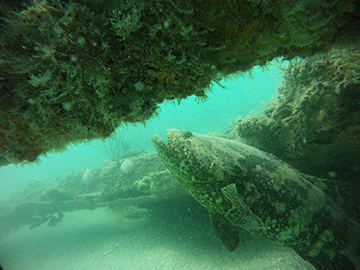
The celebrated Spanish-American War battleship, the USS Massachusetts, serves as a giant artificial reef off the coast of Pensacola. Just three-fourths of a mile off Lauderdale-by-the-Sea, the SS Copenhagen is the most-visited site, thanks to its resting spot in 15 to 30 feet of clear water and rich diversity of marine life including spiny lobsters, angelfish, red and yellowtail snapper and sea fans. Each site is interpreted by an underwater plaque; a brochure and laminated underwater guides are available from local dive shops.
The Narcissus is home to a surprising diversity of marine life, not only of fish but also of invertebrate species, including hard and soft corals. Divers have reported scaled sardines and spadefish, as well as belted sandfish, wrasse, gag grouper, flounder and sheepshead. Invertebrates include sponges, feather duster worms, orange, purple, and yellow gorgonians, sand dollars and hermit crabs.
“We’ve seen at least four goliath grouper on the site,” says Mike Terrell.
Tampa Bay Preserves
Two underwater preserves are in the Tampa Bay area — USS Narcissus and the Regina, a 247-foot-long steel tanker barge that sank in 1940 off Bradenton Beach. Regina, also known as the “Sugar Wreck” or “Molasses Barge,” was based in Havana and carried a primary cargo of molasses to ports along the East and Gulf coasts. Heading to New Orleans, she encountered a disastrous winter storm, hit a sandbar and broke apart just 200 yards off Anna Maria Island.
Now resting in shallow water partially exposed, Regina became the state’s tenth underwater archaeological preserve in 2002. Due to her proximity to the beach, the site is popular with snorkelers. Common marine life that can be seen around Regina include blue crabs, grunts, sea urchins, sea whips, sheepshead, pinfish, and toadfish.
Check out Florida’s Museums of the Sea web site at museumsinthesea.com
Marcia Biggs is a freelance writer based in Safety Harbor.
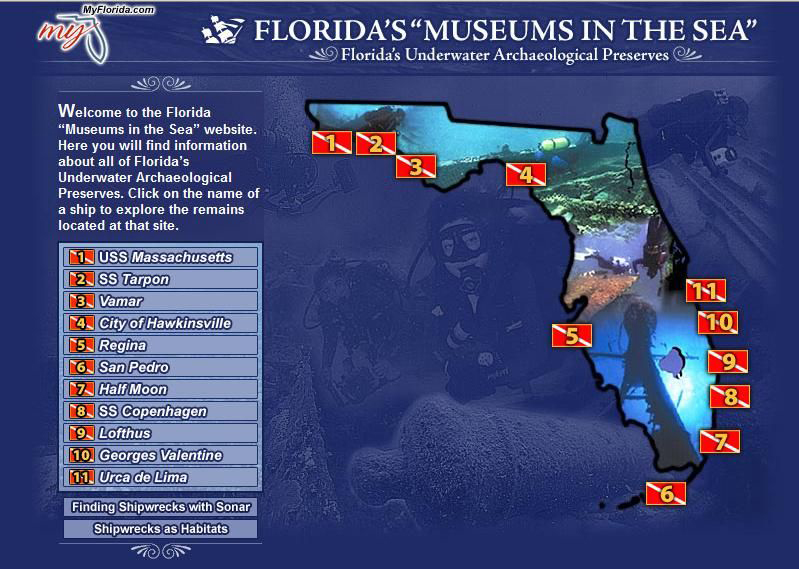
[su_divider]
